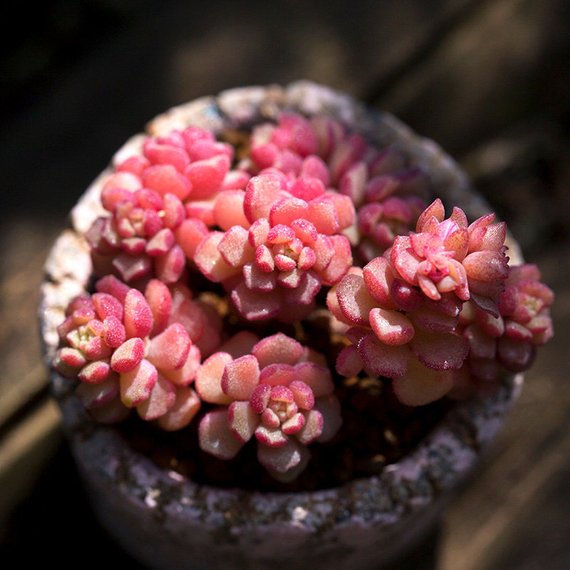Sedum versadense is a relatively small succulent plant, loved for its charming appearance and colors. Its leaves are covered with fine hairs, initially green, but under sufficient sunlight and temperature fluctuations, they gradually turn red until the entire plant becomes red. In this state, the Sedum versadense is incredibly beautiful, almost universally adored.
Sedum versadense prefers a sunny, warm, and dry environment, being relatively drought-tolerant but sensitive to excessive moisture. During the growing season, excessive watering can cause elongation of the plant, leading to sparse leaves and loss of its compact form. In summer, shading is necessary to prevent sunburn, as the small plant is highly susceptible to it.
Propagation is primarily done through stem cuttings, although leaf cuttings are also possible. Leaf-cutting seedlings are smaller and grow slower, requiring careful attention. Sedum versadense grows rapidly as a succulent, and the survival rate of leaf cuttings is generally high, making it accessible even to novice succulent enthusiasts.
Leaf Selection:
Select mature and healthy leaves from the main stem of the Sedum versadense plant. Quickly remove the leaves and allow them to air-dry in a well-ventilated area, ensuring that any wounds on the leaves are dry.
Leaf Insertion:
Place the removed leaves on prepared potting soil, ensuring that the bottom of the Sedum versadense leaves makes contact with the soil surface. Place the leaf-cutting pot in a ventilated area, maintaining a certain level of soil moisture. It won't be long before the Sedum versadense leaves root and sprout.
Rooting and Sprouting:
Once the leaves have developed roots, they can be watered regularly, but the amount of water should be controlled. Water immediately when the soil surface dries out, ensuring sufficient humidity for healthy growth. Watering can also be accompanied by a brief exposure to sunlight.
Growing Environment:
Sedum versadense loves sunlight and should be placed in a sunny location during the growing season, receiving as much sunlight as possible. However, in summer, shading is necessary to prevent leaf burning due to high temperatures and intense sunlight. In winter, it should receive sunlight throughout the day to facilitate safe overwintering.
Repotting:
Repot every 1-2 years, preferably in spring.
Watering:
Sedum versadense is drought-tolerant, so water sparingly to avoid root rot. During the growing season, water after the soil has dried out completely. During dormancy, especially in winter, reduce watering, and cease completely if temperatures drop too low.
Potting Soil:
Like other succulents, Sedum versadense requires loose and well-draining soil. A mixture of peat moss and perlite is suitable for potting, ensuring that the substrate is free of pathogens and insect eggs.
Fertilization:
Sedum versadense requires some nutrients for growth, typically supplemented monthly with specialized succulent fertilizer. During periods of extreme temperatures, such as high or low temperatures, growth slows down, and fertilization may not be necessary.
